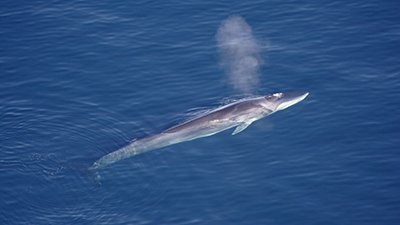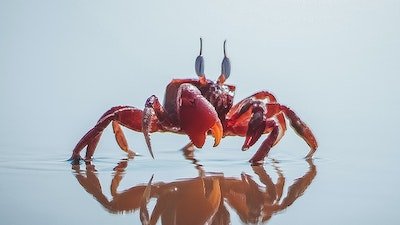Dolphins by Design?
Dolphins-by-design or big-thinkers-that-bumbled-into-existence?
News Source
- Science: “Building a Bigger Dolphin Brain”
How dolphins were able to “evolve such large noggins”1 is the “just so story” recently brought to light by evolutionary biologist Michael McGowen from Detroit’s Wayne State University and colleagues. The team, whose work was published June 27 in the Proceedings of the Royal Society B, compared the genomes of dolphins, cows, horses, dogs, mice, elephants, humans, chickens, and even the platypus.2
The well-known evolutionary tale tells of how nearly 50 million years ago a land-based ancestor traded in its limbs for fins, learned to hold its breath a long time, and tripled its brain size to eventually produce dolphins. The story is particularly interesting when compared to the story about how ape-like ancestors learned to walk upright before bumping up their brain size to become ancestral humans. In both scenarios, the upward evolving mammal—be it terrestrial or aquatic—acquired “complex cognitive capacities.”3 The team writes that their results provide “some evidence for convergent [evolutionary] features in the genomes of dolphins and primates.”4 Apparently altering the standard method of locomotion and getting up off of all fours is key to intellectual evolutionary progress!
The team examined 10,000 protein-coding genes in the dolphin and compared them to genes in land animals. Because of their presupposition that land mammals evolved before cetaceans (dolphins and whales)—they defined the 228 differences they found as mutations. Mutations are changes. They see these observable present-day differences as evidence of unobservable changes from a hypothetical common ancestor. Some of these differences involved genes associated with brain growth, neuronal interconnections, sleep, and “human intellectual disabilities.”5
Because of their presupposition that land mammals evolved before cetaceans (dolphins and whales)—they defined the 228 differences they found as mutations.
Because bigger brains and increased cognitive abilities would need to be fueled efficiently, genes coding for more efficient glucose transport across the blood-brain barrier than that found in the land animals were also considered evidence of “adaptive evolution.”6 Other genetic differences seemed associated with having lots of mitochondria, an important cellular feature for active animals with a high metabolic rate—such as large aquatic mammals. (Swimming is hard work for any mammal, after all, even for a dolphin.)
Because these genetic differences are interpreted by the researchers as remnants of dolphin evolution from land animals, they are considered a roadmap clocking the evolution of the ancestral dolphin. Calculations of rates of molecular evolution, however, do not prove animals evolved from other kinds of animals but simply assume such evolution happened and then calculate how long it supposedly took.
The unique features blueprinted by the dolphin genome are merely the design features required for significant animal cognitive abilities and for efficient life in the water—a life for which God equipped certain of His creatures when He created all kinds of creatures about 6,000 years ago. The other genes are similar because they code for proteins and structures needed in many creatures designed by God, the common Designer of all. Animals were created to reproduce after their kinds, not to evolve into new kinds, and that is what we observe in nature.
God told us in Genesis 1:21 what He did and when. On the 5th day of Creation Week—one day before He created land animals—“God created great sea creatures and every living thing that moves, with which the waters abounded, according to their kind.” And when some Christians—such as theistic evolutionists—try to merge evolutionary dogma with the Bible, they, in effect, accuse God of lying, being incapable of communicating effectively, or being too forgetful to remember the order in which He did things.
For More Information: Get Answers
Remember, if you see a news story that might merit some attention, let us know about it! (Note: if the story originates from the Associated Press, FOX News, MSNBC, the New York Times, or another major national media outlet, we will most likely have already heard about it.) And thanks to all of our readers who have submitted great news tips to us. If you didn’t catch all the latest News to Know, why not take a look to see what you’ve missed?
(Please note that links will take you directly to the source. Answers in Genesis is not responsible for content on the websites to which we refer. For more information, please see our Privacy Policy.)
Footnotes
- C. Arnold, “Building a Bigger Dolphin Brain,” Science, June 26, 2012, http://www.sciencemag.org/news/2012/06/building-bigger-dolphin-brain.
- M. McGowen, L. Grossman, and D. Wildman, “Dolphin Genome Provides Evidence for Adaptive Evolution of Nervous System Genes and a Molecular Rate Slowdown,” Proceedings of the Royal Society B; Biological Sciences, June 27, 2012, doi:10.1098/rspb.2012.0869.
- Ibid.
- Ibid.
- Ibid.
- Ibid.

Answers in Genesis is an apologetics ministry, dedicated to helping Christians defend their faith and proclaim the good news of Jesus Christ.
- Customer Service 800.778.3390
- © 2024 Answers in Genesis




